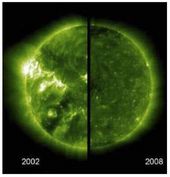From this NASA document (PDF here)
ROSES-09 Amendment 1: New proposal opportunity in Appendix B.9:
Causes and Consequences of the Minimum of Solar Cycle 23
This amendment establishes a new program element in Appendix B.9 entitled Causes and Consequences of the Minimum of Solar Cycle 23. This new program element solicits proposals to study the causes and consequences of the minimum of Solar Cycle 23. Proposals are encouraged that take advantage of this opportunity with studies of domains ranging from the center of the Sun through terrestrial and planetary space environments to the boundary of the heliosphere. High priority will be given to studies addressing the interaction between various regimes.
Notices of Intent to propose are due April 17, 2009, and proposals are due June 5, 2009.
On or about March 6, 2009, this Amendment to the NASA Research Announcement Research Opportunities in Space and Earth Sciences (ROSES) 2009 (NNH09ZDA001N) will be posted on the NASA research opportunity homepage at (Link) (select Solicitations then Open Solicitations then NNH09ZDA001N).
Further information about the Causes and Consequences of the Minimum of Solar Cycle 23 program element is available from Dr. Mary Mellott, Heliophysics Division, Science Mission Directorate, NASA Headquarters, Washington, DC 20546; Telephone: (202) 358-0893; E-mail: mary.m.mellott@nasa.gov.
Michael Ronanye writes:
This is a three year project with funding of 1.5 million dollars per year and total funding of 4.5 million dollars over the life of the project. This is a very good insurance and CYA policy on NASA's part. They may get some interesting research out of the project and if conditions on the Sun take an unexpected turn, they can always say: "Yes Senator, NASA was right of top of the situation and we funded this new project on 3/5/2009"!From the document:
.9 CAUSES AND CONSEQUENCES OF THE MINIMUM OF SOLAR CYCLE 23 (Link)
B.9 CAUSES AND CONSEQUENCES OF THE MINIMUM OF SOLAR CYCLE 23
1. Scope of Program
In 2009, we are in the midst of the minimum of solar activity that marks the end of Solar Cycle 23. As this cycle comes to an end we are recognizing, in retrospect, that the Sun has been extraordinarily quiet during this particular Solar Cycle minimum. This is evidenced in records of both solar activity and the response to it of the terrestrial space environment. For example:
Causes - Solar output
Consequences
- Lowest sustained solar radio flux since the F 10.7 proxy was created in 1947;
- Solar wind global pressure the lowest observed since the beginning of the Space age;
- Unusually high tilt angle of the solar dipole throughout the current solar minimum;
- Solar wind magnetic field 36% weaker than during the minimum of Solar Cycle 22;
- Effectively no sunspots;
- The absence of a classical quiescent equatorial streamer belt; and
- Cosmic rays at near record-high levels.
Thus, we have an unprecedented opportunity to characterize the quiet/background state of the heliosphere when the solar source function is as close to the ground state as it has been in the modern era.
- With the exception of 1934, 2008 had more instances of 3-hr periods with Kp=0 than any other year since the creation of the index in 1932;
- Cold contracted ionosphere and upper atmosphere; and
- Remarkably persistent recurrent geomagnetic activity.
NASA's Heliophysics Division wishes to facilitate study of this special period. This ROSES element thus solicits proposals to study the Causes and Consequences of the Minimum of Solar Cycle 23 (CCMSC). Proposals are encouraged that take advantage of this opportunity with studies of domains ranging from the center of the Sun through terrestrial and planetary space environments to the boundary of the heliosphere. High priority will be given to studies addressing the interaction between various regimes.
Taking maximum advantage of this opportunity will require interaction between specialists in different regimes. Selected Principal Investigators will have responsibilities for both their own specific research and for participation in a yearly workshop where all the CCMSC investigators will be brought together to explore the implications of their own work for other regions. Proposals should address both of these responsibilities.




Comment: Let's take another look at those bullet points -
Causes - Solar output
- Lowest sustained solar radio flux since the F 10.7 proxy was created in 1947;
- Solar wind global pressure the lowest observed since the beginning of the Space age;
- Unusually high tilt angle of the solar dipole throughout the current solar minimum;
- Solar wind magnetic field 36% weaker than during the minimum of Solar Cycle 22;
- Effectively no sunspots;
- The absence of a classical quiescent equatorial streamer belt; and
- Cosmic rays at near record-high levels.
Consequences- With the exception of 1934, 2008 had more instances of 3-hr periods with Kp=0 than any other year since the creation of the index in 1932;
- Cold contracted ionosphere and upper atmosphere; and
- Remarkably persistent recurrent geomagnetic activity.
Interesting how all the man made global warming rhetoric drowns out much of any talk in the mainstream regarding something so significant as what is going on with the sun right now. Ask an average person if they are aware of any of this information. Then ask that same person what they have heard about global warming.News and science has been turned over to the pop culture media and left the average person without a clue as to what is really going on in their own reality.